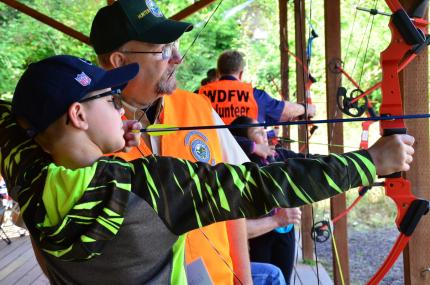Pre-registration for National Hunting and Fishing Day is closed. You may still register in-person at the event. If you have any questions or need assistance, please contact kristopher.thorson@dfw.wa.gov.
For more information about this event, read the news release in the WDFW newsroom. To volunteer for National Hunting and Fishing Day, visit the volunteer events list webpage.
The Washington Department of Fish and Wildlife's (WDFW) National Hunting and Fishing Day celebration is a great, family-oriented way to introduce youth to target shooting, hunting and fishing. It's also an opportunity to recognize that hunters and anglers continue to be among the most active supporters of wildlife management and conservation.
This year's event will take place on Sept. 28, 2024, from 9 a.m. to 3 p.m. at the Cowlitz Public Shooting Range located at 1000 Toutle Park Rd, Castle Rock, WA 98611. Participants can pre-register to attend one of two sessions during the event. Session one is 9 a.m. to 11:30 a.m. and session two is 12 p.m. to 2:30 p.m.
Youth 17 years and younger who attend the event with an accompanying adult can shoot WDFW firearms, archery equipment and air rifles for free. Agency staff and WDFW hunter education instructors will be on hand to teach shooting safety and provide instruction and guidance.
The event also features:
- Conservation organization displays and info
- Door prize drawings
- Fun giveaways
- Casting practice
- Knot tying
- Fish prints
- Track plaster casting
Volunteers are needed to help make National Hunting and Fishing Day a huge success. Registration is now open for individuals interested in helping staff this important event. To volunteer for NHFD and other events, visit the Volunteer event list webpage.
Notice of Photography and/or Videography. When you attend this event, you enter an area where photography and/or videography (which includes audio recording) may occur. By entering the event premises, you consent to such photography and/or videography and their release, publication, exhibition, or reproduction by the Washington Department of Fish and Wildlife. If you prefer not to have your photo and/or video taken, please inform WDFW staff immediately upon arrival. Staff will provide a sticker or tape for you to wear. You must wear the sticker/tape at all times. WDFW will make an effort to edit or remove any photos and/or video of you in which the sticker/tape is present. Any photos and/or videos posted in error will be immediately edited or removed upon request. Due to the nature of audio recording that is a necessary part of videography, WDFW cannot warrant that outside/ambient audio from other individuals won’t be captured and released as part of said videography. All parties attending such an event consent to WDFW using such outside/ambient audio recording as part of any videography process.
About National Hunting and Fishing Day

In the 1960s, hunters and anglers embraced the era's heightened environmental awareness but were discouraged that many people didn't understand the role that sportsmen and women played -- and continue to play -- in the conservation movement.
With urging from the National Shooting Sports Foundation, Congress unanimously authorized National Hunting and Fishing Day on the fourth Saturday of every September. On May 2, 1972, President Richard M. Nixon signed the first proclamation of the annual celebration.
Today, National Hunting and Fishing Day continues as an opportunity to celebrate outdoor sports and conservation -- and as a day to share the pride in conservation successes led by hunters and anglers across the nation.
Hunting and conservation
In March 2016, the U.S. Fish and Wildlife Service distributed $1.1 billion in revenues, collected from fishing- and hunting-related excise taxes to support outdoor recreation and conservation efforts in all 50 states through the Pittman-Robertson Wildlife Restoration and Dingell-Johnson Sport Fish Restoration acts. The state of Washington received $20 million of this funding.
This is not a new phenomenon; billions of dollars have been contributed to state agencies since the 1930s by American hunters and anglers in support of conservation and wildlife management efforts.
Facts about hunting and fishing:
- More than 34 million Americans six years of age and older enjoy fishing every year.
- More Americans hunt and shoot than play baseball.
- Twenty-five percent of anglers are female; and women and teenage girls represent one of the fastest growing groups of new hunters.
Funding from hunters has helped restore wildlife populations and habitat:
- Whitetail deer populations have rebounded nationally to 30 million from just 500,000 deer in 1900.
- Wild turkey populations have rebounded to over 7 million from 100,000.
- Rocky Mountain elk populations have rebounded from 41,000 in 1907 to over one million today.
- Revenue from hunting excise taxes has purchased millions of acres of habitat, maintained by state wildlife agencies.
- These lands support game and non-game species alike, as well as provide rich opportunities for outdoor recreation such as birdwatching, hiking, camping, climbing and canoeing.
Funding from anglers helps manage America's 3.5 million miles of rivers, 40.8 million acres of lakes, 34,400 square miles of estuaries, 58,000 miles of ocean shoreline and 277 million acres of wetlands.
Hunters and anglers have been among the nation's largest contributors to conservation, paying for programs that benefit America's wildlife and all who enjoy the outdoors
(Sources: National Hunting and Fishing Day, USFWS, and the National Shooting Sports Foundation)